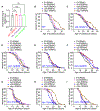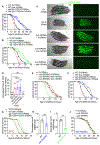A mitochondrial unfolded protein response-independent role of DVE-1 in longevity regulation
- PMID: 39423131
- PMCID: PMC11648574
- DOI: 10.1016/j.celrep.2024.114889
A mitochondrial unfolded protein response-independent role of DVE-1 in longevity regulation
Abstract
The special AT-rich sequence-binding (SATB) protein DVE-1 is widely recognized for its pivotal involvement in orchestrating the retrograde mitochondrial unfolded protein response (mitoUPR) in C. elegans. In our study of downstream factors contributing to lifespan extension in sensory ciliary mutants, we find that DVE-1 is crucial for this longevity effect independent of its canonical mitoUPR function. Additionally, DVE-1 also influences lifespan under conditions of dietary restriction and germline loss, again distinct from its role in mitoUPR. Mechanistically, while mitochondrial stress typically prompts nuclear accumulation of DVE-1 to initiate the transcriptional mitoUPR program, these long-lived mutants reduce DVE-1 nuclear accumulation, likely by enhancing its cytosolic translocation. This observation suggests a cytosolic role for DVE-1 in lifespan extension. Overall, our study implies that, in contrast to the more narrowly defined role of the mitoUPR-related transcription factor ATFS-1, DVE-1 may possess broader functions than previously recognized in modulating longevity and defending against stress.
Keywords: ATFS-1; C. elegans; CP: Cell biology; CP: Molecular biology; DVE-1; cilia; dietary restriction; germline signaling; longevity; mitoUPR.
Copyright © 2024 The Author(s). Published by Elsevier Inc. All rights reserved.
Conflict of interest statement
Declaration of interests The authors declare no competing interests.
Figures







References
Publication types
MeSH terms
Substances
Associated data
- Actions
Grants and funding
LinkOut - more resources
Full Text Sources
Molecular Biology Databases
Research Materials
Miscellaneous

